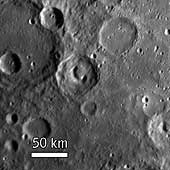|
COMETS EARTH JUPITER KUIPER BELT MARS MERCURY METEORITES NEPTUNE OORT CLOUD PLUTO SATURN SOLAR SYSTEM SPACE SUN URANUS VENUS ORDER PRINTS
PHOTO CATEGORIES SCIENCEVIEWS AMERICAN INDIAN AMPHIBIANS BIRDS BUGS FINE ART FOSSILS THE ISLANDS HISTORICAL PHOTOS MAMMALS OTHER PARKS PLANTS RELIGIOUS REPTILES SCIENCEVIEWS PRINTS
|
Related Documents
Download Options
MESSENGER's Narrow Angle Camera (NAC) on the Mercury Dual Imaging System (MDIS) acquired this view of Mercury's surface illuminated obliquely from the right by the Sun. The unnamed crater (52 kilometers, or 31 miles, in diameter) in the center of the image displays a telephone-shaped collapse feature on its floor. Such a collapse feature, not seen on the floors of other craters in this image, could reflect past volcanic activity at and just below the surface of this particular crater. MESSENGER team members are examining closely the more than 1200 images returned from this flyby for other surface features that can provide clues to the geological history of the innermost planet. The crater is located in the southern hemisphere of Mercury, on the side that was not viewed by Mariner 10 during any of its three flybys (1974-1975). This scene was imaged while MESSENGER was departing from Mercury from a distance of about 19,300 kilometers (12,000 miles), about 1 hour after the spacecraft's closest encounter with Mercury. The image is of a region approximately 236 kilometers (147 miles) across, and craters as small as 1.6 kilometers (1 mile) can be seen. Mission Elapsed Time (MET) of image: 108828208 Credit: NASA/Johns Hopkins University Applied Physics Laboratory/Carnegie Institution of Washington |
